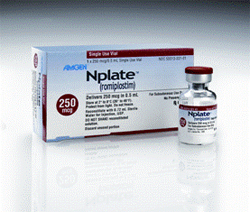Product
Nplate (romiplostim)
Approval Date
Aug. 22, 2008
Company
Amgen
Class
Thrombopoietin TPO receptor agonist
Indication
For the treatment of adult chronic immune thrombocytopenic purpura (ITP).
Active Ingredient
Romiplostim (recombinant) 250mcg, 500mcg; per vial; lyophilized pwd for SC inj after reconstitution; contains sucrose and mannitol; preservative-free.
Marketing Strategy/Execution
Amgen is committed to ensuring the appropriate use of Nplate, and has launched the Nplate NEXUS Program, a multi-faceted program designed to provide comprehensive access, support and education for chronic ITP patients, their caregivers and healthcare providers.
Also in the Pipeline (courtesy of Adis R&D Insight)
Drug: LGD 4665
Manufacturer: Ligand Pharmaceuticals
Indication: Thrombocytopenia
Active ingredient: TPO mimetic
Phase: II
Source: WoltersKluwer Health
Pharmacology
Nplate is a member of the thrombopoietin (TPO) mimetic class. It is an Fc-peptide fusion protein that activates intracellular transcriptional pathways leading to increased platelet production via the TPO receptor. Nplate produces dose-dependent increases in platelet production by binding and activating the TPO receptor in a mechanism similar to endogenous TPO.
Clinical Trials
The safety and efficacy of Nplate was evaluated in 2 open-label, placebo-controlled clinical trials of chronic ITP patients with or without splenectomies and platelet counts =30×109/L. Patients in both studies received weekly SC injections individually adjusted to maintain platelet counts between 50 to 200×109/L.
Splenectomized patients achieved an overall platelet response of 79% versus 0%, when compared to placebo. Non-splenectomized patients achieved an overall platelet response of 88% versus 14%, when compared to placebo. A reduction or discontinuation of baseline concurrent ITP treatments were also seen in both groups compared to placebo.
Adverse Reactions
Arthralgia, dizziness, insomnia, myalgia, pain in extremity, abdominal pain, shoulder pain, dyspepsia, paresthesia, headaches; bone marrow reticulin deposition, worsening thrombocytopenia, risk of bleeding, thrombotic/thromboembolic complications, antibody formation.
Adults
Give by SC inj. To reduce risk of bleeding: use lowest effective dose to achieve and maintain platelets =50×109/L. =18yrs: initially: 1mcg/kg weekly; may increase by 1mcg/kg if platelets <50×109/L; max: 10mcg/kg weekly. May reduce by 1mcg/kg if platelets >200×109/L for 2 consecutive weeks. Do not dose if platelets >400×109/L; resume Nplate at a dose reduced by 1mcg/kg when platelets fallen to <200×109/L. Discontinue if platelets has not increased after 4 weeks at max dose.
Children
<18yrs: not recommended.
Precautions
Not for normalization of platelet counts. Risk of bone marrow fibrosis with cytopenias. Worsened thrombocytopenia after discontinuation. Monitor CBCs, platelets, and peripheral blood smears before and weekly during dose adjustments then monthly after achieving stable dose; and weekly for 2 weeks after discontinuation of therapy. Monitor after initial response for formation of neutralizing antibodies. Risk of hematologic malignancies (esp. myelodysplastic syndrome). Renal or hepatic impairment. Elderly. Pregnancy (Cat.C). Nursing mothers.
Interactions
May increase bleeding risk with anticoagulants or antiplatelet agents.








